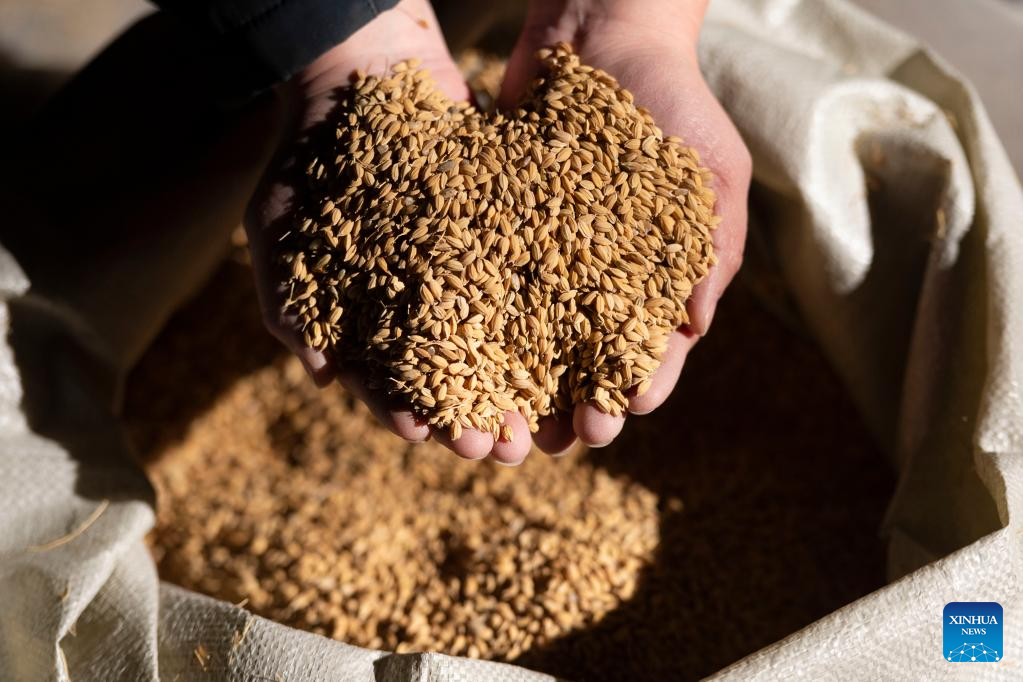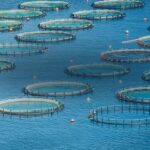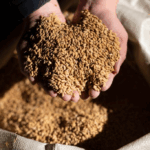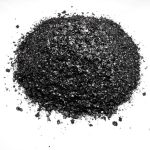Sodium humate flakes are a natural, organic substance that comes from humic acid, which is formed when plant and animal matter, like leaves or ancient plant deposits, breaks down over thousands of years. This breakdown happens in materials like leonardite or lignite, which are soft, coal-like substances rich in organic compounds. Sodium humate is created by combining humic acid with sodium, resulting in dark brown or black flakes that dissolve easily in water. These flakes are popular in farming, gardening, animal care, and even some industrial uses because they’re natural, versatile, and relatively easy to use. Think of them as a multi-purpose helper for improving soil, boosting plant growth, or supporting animal health.
What Makes Sodium Humate Special?
The magic of sodium humate lies in its ability to interact with soils, plants, and even animal digestive systems. Its water solubility makes it super practical—you can mix it into water and apply it directly to soil, spray it on plants, or add it to animal feed. It’s packed with humic substances, which are complex organic molecules that help with nutrient absorption, soil health, and detoxification. Because it’s derived from natural sources, it’s considered eco-friendly and safe when used correctly, which is a big draw for farmers and gardeners looking to avoid synthetic chemicals.
In-Depth Uses of Sodium Humate Flakes
1. Farming and Gardening
Sodium humate flakes are a favorite in agriculture and horticulture, where they’re used to improve soil and help plants grow better. Here’s how they work in this area:
- Fixing Soil Problems: If you’ve got hard, compacted soil, sodium humate can help loosen it up. This makes it easier for plant roots to spread out and grow strong. It’s especially helpful in clay soils that get dense and heavy.
- Holding Water Better: Sodium humate acts like a sponge in the soil, helping it retain water. This is a lifesaver in dry areas or during hot summers when plants might struggle to get enough moisture.
- Making Nutrients Work Better: Plants need nutrients like nitrogen, potassium, and iron to grow, but sometimes these nutrients get locked up in the soil. Sodium humate acts like a key, binding to these nutrients and making them easier for plants to absorb. This can mean healthier plants and bigger harvests.
- Boosting Plant Growth: The humic substances in sodium humate can kickstart plant processes, like enzyme activity or root development. This can lead to faster-growing plants, stronger roots, and more flowers or fruit.
- Helping Soil Microbes: Healthy soil is full of tiny organisms that break down organic matter and recycle nutrients. Sodium humate feeds these microbes, creating a livelier, more fertile soil environment.
Farmers and gardeners use sodium humate in a few ways:
- Soil Drench: Mix the flakes into water and pour it onto the soil around plants.
- Foliar Spray: Dissolve it in water and spray it directly onto leaves for quick absorption.
- Seed Soaking: Soak seeds in a sodium humate solution before planting to give them a head start.
It works for all kinds of plants—vegetables, fruits, grains, flowers, and even lawn grass.
2. Animal Feed Additive
Sodium humate flakes aren’t just for plants; they’re also used in animal farming, like for cows, pigs, chickens, and even fish. Here’s what they do for animals:
- Better Digestion: Adding sodium humate to feed or water can help animals break down their food more effectively. It supports a healthy gut, which means animals can get more nutrients from their feed.
- Cleaning Out Toxins: Sodium humate can grab onto harmful substances, like toxins or heavy metals, in an animal’s digestive system and help flush them out. This keeps animals healthier and less stressed.
- Stronger Immunity: By improving gut health and reducing toxins, sodium humate might help animals fight off sickness better, though this is still being studied.
- Reducing Farm Odors: In places like chicken coops or pig barns, sodium humate can cut down on ammonia smells from manure. This makes the environment better for animals and workers and reduces pollution.
Farmers typically mix a small amount of sodium humate into animal feed or drinking water. The exact amount depends on the animal, but it’s usually a tiny percentage of the feed.
3. Other Uses
Sodium humate flakes have some surprising uses outside of farming:
- Cleaning Water: In water treatment, it can act like a magnet, pulling out impurities and making water cleaner.
- Oil and Gas Drilling: It’s sometimes added to drilling fluids to keep things stable and prevent leaks in the drilling process.
- Fixing Damaged Land: If soil has been contaminated by heavy metals or chemicals, sodium humate can help trap those pollutants, making the soil safer for plants or animals.
Why Use Sodium Humate Flakes?
There’s a lot to like about sodium humate flakes:
- Good for the Environment: Since they come from natural sources, they’re a sustainable choice for people who want to avoid synthetic chemicals.
- Saves Money: A little goes a long way, so you don’t need to use a lot to see results. This can cut down on the need for expensive fertilizers or feed additives.
- Easy to Use: The flakes dissolve in water, so you can apply them in multiple ways depending on what you need.
- Safe for Most Uses: When used as directed, sodium humate is generally safe for plants, animals, and people. It’s even approved for organic farming in many cases.
Things to Watch Out For
While sodium humate is generally a great tool, there are a few things to keep in mind:
- Quality Matters: Not all sodium humate is created equal. Some products might have lower levels of humic acid, which means they won’t work as well. Look for products with 60-80% humic acid content for the best results.
- Results Vary: What works in one field or with one type of animal might not work as well in another. Soil types, plant needs, and animal health all play a role.
- Don’t Overdo It: Using too much sodium humate in soil can mess with nutrient balances, so stick to recommended amounts.
- Still Being Studied: While lots of farmers swear by sodium humate, scientists are still researching exactly how it works and how effective it is in different situations.
How to Use Sodium Humate Flakes
Here’s a step-by-step guide to using sodium humate flakes effectively:
For Plants
- Soil Application: Mix 1-2 teaspoons of flakes per gallon of water (or about 10-50 kg per hectare for large fields). Pour it around the base of plants or add it to your irrigation system.
- Leaf Spray: Dissolve a smaller amount (about 1/4 to 1/2 teaspoon per gallon) and spray it on plant leaves. Do this early in the morning or late in the day to avoid burning the leaves.
- Seed Treatment: Soak seeds in a weak solution (1/8 teaspoon per gallon) for a few hours before planting to improve germination.
- Timing: Apply every 2-4 weeks during the growing season for best results.
For Animals
- Feed Mixing: Add sodium humate to feed at a rate of 0.5-2% of the total feed weight. For example, mix 5-20 grams per kilogram of feed.
- Water Additive: Dissolve a small amount (consult a vet for exact doses) into drinking water.
- Start Slow: Begin with a low dose and watch how your animals respond. Check with a veterinarian to make sure it’s safe for your specific animals.
Storage Tips
- Keep the flakes in a dry, cool place, like a shed or garage, to prevent them from clumping or losing potency.
- Use gloves or a mask if you’re handling large amounts to avoid breathing in dust.
Practical Tips for Beginners
If you’re new to sodium humate, here’s how to get started:
- Try a Small Test: Before using it on your whole garden or farm, test it on a small patch of soil or a few animals. This lets you see how it works without committing too much.
- Pair It Smartly: Sodium humate works great alongside compost, manure, or microbial fertilizers, but don’t mix it with super acidic or alkaline products, as they can reduce its effectiveness.
- Buy from Trusted Sources: Check for suppliers that provide lab-tested products with clear humic acid content. Online marketplaces or farm supply stores often carry it.
- Keep Track: Write down what you apply, when, and what changes you notice (like better plant growth or healthier animals). This helps you figure out what works best.
- Ask Around: Talk to local farmers, gardeners, or extension agents to see how they use sodium humate in your area.
Where to Learn More
Want to dive deeper? Here are some places to look:
- Local Extension Services: Many universities or government agencies have agricultural programs with free guides on soil amendments like sodium humate.
- Online Research: Websites have studies on humic substances and their effects on plants and animals.
- Supplier Resources: Companies that sell sodium humate often include detailed instructions or case studies on their websites.
- Farmer Communities: Check out forums or social media groups where farmers and gardeners share their experiences with sodium humate.
Wrapping It Up
Sodium humate flakes are like a Swiss Army knife for farming, gardening, and animal care. They can improve your soil, help your plants thrive, and even make your animals healthier—all while being natural and eco-friendly. The key is to use them thoughtfully: start small, stick to recommended amounts, and choose a high-quality product. Whether you’re growing tomatoes in your backyard or managing a large farm, sodium humate could be a game-changer.









